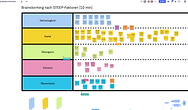
Lexus Lodge
KOSI
A Kick Off Sprint for Innovators
The KOSI Sprint is an Innovation Sprint for inter-
and multidisciplinary Teams from agencies, companies or institutions.
The Sprint was develop from the knowledge of a great research.
The Methods support a productive Kick-Off and a strategic
approach into the following innovation process.
Challenge.
01
The sprint was designed in the framing of my Master Thesis which was written in the beginning of the corona crisis.
This pandemic shows us the importance of a proactive innovation culture more than never.
So we decided to create an easy and cheap way to support the innovation culture, to bring different disciplines together and to bring structure into the fuzzy start of every innovation process.
All in all we used the power of Design methodologies, as well as methodologies from management, strategy and research.

"The key point, however, is not interdisciplinary knowledge, but rather to create framework conditions to build bridges between the most diverse disciplines.
Openness to knowledge from other disciplines and an allowance of the different opinions and approaches to solutions associated with it."
Günther Wagner, 2019
Research.
02
The wide research began with a starting point in the areas of digital transformation, innovation, processes and organizational structures. Furthermore, this led us into future- and trend research and its methologies, — as well as scenario techniques, which helped us a lot in the design of the workshop.
The research was done by a desktop and literature research and was rounded off by different expert interviews.




-
Digital Transformation
-
Innovation
-
Organizational Structures
-
Innovationsprcesses
-
Trend Research
-
future research
-
Methods
-
Szenario Technique
-
Futures Cone
-
Methods
-
KOSI -Sprint
-
Design & Testing
Conducted by the Bertelsmann Stiftung in 2019 a main problem is:
Only a few companies in Germany have the innovative strength to secure their competitive position in the long term.
Even around half of the companies in this country do not actively promote innovation. The willingness to take risks and a successful innovation culture are missing.


As a reason for that is the clear connection between innovation and economic efficiency, especially in small and medium-sized companies.
However, economic efficiency gets more importance in first sight. Real, disruptive and sustainable Innovations are not proactively driven forward enough.
It is becoming more and more important to develop a proactive will to innovate, because, as we were able to see during the pandemic, it will not be enough to make business models "digital" in order to sustainably survive with the business model in the future.
But why it is so important to act actively in order to innovate sustainable? ...

The Lazy eight, a systemic model from resilience research, describes life and renewal phases in the cycle of a system and can be related to the BCG Matrix.
Every successful product brings security and is a 'cash cow' for a company.
At some point, however, this one-dimensional growth reaches a peak, which means that a regress or the 'poor dog' moment will follow.
Now it's time to innovate...but here comes the exciting point.
It is a disadvantage to innovate from of a crisis, because there is a pressure to experience growth again. This will pressure will lead to incremental innovations instead of sustainable ones or 'rising stars'.
The cycle will only be sustainable if the company actively seeks for an innovative "restart" which can replace current products with real new values.
This is how new growth can be driven forward.

Define.
03
With this big research we got a holistic view about this topic. So we were able to localize different problem and starting points.
In addition, we were confirmed in our assumption that there is great relevance here and that we can create added value with our resources as designers.
As Cooper & Kleinschmidt quotes below, we started to have a look at the innovation processes and tools:
-
Problems in idea generation
-
Lack of understanding user needs
-
low willingness to take risks
-
Communication and understanding problems
-
Undefined product definition & strategy
-
Unclear tasks & coordination

Cooper & Kleinschmidt

With the analysis of different processes, research results from literature and expert interviews we came up with the fuzzyness in the beginning of these processes.
The closer we are getting to the beginning of the processes, the more disorder and differences (fuzzyness) become visible.
We as designers are familiar with this 'fuzzyness' in the beginning, so we may can transfer our way of thinking and methodologies on the innovation process to structure and create a level of communication within the different disciplines.




After a detailed check of different Innovation processes, we focused on the phase before the Idea generation.
We called this section "incubation phase" because different values are analyzed and structured here for the following steps.
This holistic view on the early stage can bring enormous advantages on product development as well as for the project structure itself:
• Strategic adaptation of the innovation process and strategic product planning
• Planning of the product portfolio
• early and precise definition
• Market & Technology Evaluation
• Accurate analysis of user needs
• Prioritization of product details
• Recognize a need for change in the definition
• evaluate priorities of the project
• planning needed resources
• Evaluation of the unpredictability
• Role of the manager
• Organization of the team
• Communication within the organization
Product Strategy
Product definiton
Project definition
Organizational

From the development of ideas, through implementation to market launch, there is often more certainty than with upstream steps.
During these steps, the causes for the problems in later process phases usually already arise. In addition, other effects can be used at the beginning, which can have a great leverage on the entire process.
Ideate.
04
Our starting point is to use the momentum at the beginning to improve problem areas and thus promote an impact on the entire process. The leverage on the process is greatest right at the beginning. If neuralgic problem points are taken into account here at an early stage, iterations and changes are possible with a much smaller expenditure of resources than at later points in the process. In addition, fostering a creative and knowledge exchange within the company here has the least impact on time and resource consumption and promotes the creative freedom necessary for the company's ability to innovate.
Therefore, we believe that for an actively lived innovation culture, it is important to actively and collaboratively look for new opportunity areas and make these results transparent and usable for all. In this way, the following problem areas could be improved:
Implicit knowledge and skills must be recognized and used! This is where internal innovation potential lies dormant.

Innovation processes must be initiated regularly and of their own volition so that an active innovation culture can develop!

Communication is an important key in the team, but also at interfaces to different levels.


Inter- and multidisciplinarity is indispensable for an innovative climate and must be promoted!

Information about user needs and how they change must always be in focus.

Transparent information is essential for productive communication and participation across interfaces....
Therefore, we asked ourselves how we as designers can create improvement at problem points without requiring large amounts of resources and time and unnecessarily increasing the complexity?...
We believe that a systematic and analyzed collection of information right at the beginning of the innovation process can have a positive effect on the further process and its problem areas. User needs are brought directly into focus and value creation opportunities become visible, which significantly supports the development of ideas. The basis developed in the interdisciplinary or multidisciplinary team can improve the willingness to take risks, as well as coordination and communication in the further course of the process.


Following on from this, we were able to identify great potential in the scenario technique. This enables us to extrapolate the information base into future possibility spaces and to make variables recognizable, which are helpful in idea generation, goal formation and strategic foresight.
Subsequently, methods from trend and future research, as well as the scenario technique, were selected and abstracted in order to create a transfer to creative methods. These were combined with analytical and design thinking methods to create a creative design sprint, which was then tested and iterated in several loops.



Create.
05
The "Kick-Off Sprint for Innovators" is a sprint for inter- and multidisciplinary teams in companies, agencies or institutions. The goal is a productive kick-off for idea development and evaluation of the innovation process.
The Kosi Kit consists of three sections, which can be worked on independently of each other. In this way, individual time and content requirements can also be addressed.
In addition, moderator cards are available to guide the moderator through the steps so that the sprint can be learned and moderated quickly by anyone.



Target Group
The target group of the workshop refers to companies with an independent will to innovate and inter- or multidisciplinary team compositions for innovation work.
Due to the contextual differences of companies - depending on industry, size, organizational structure and specialization - there can be very many possibilities of team composition and number of levels or areas. Advantageous is a multidisciplinary team, mixed with persons of leading levels or persons in interface areas. There are no limits here up to a group size of 10 people. The workshop can be conducted both digitally and analogously.
Empowerment
It is important that the sprint is quick and easy to understand and execute by a wide variety of steakholders. In order to empower, there must be no protracted phases. This way, efficiency is in the foreground and the culture of innovation can be actively and regularly stimulated.
Through the joint creative creation from the knowledge of different disciplines or departments, a level of communication is created which allows new perspectives to be taken and one's own to be expanded.
Knowledge about users, needs, problems and value creation opportunities are gathered to serve as a new source of innovative ideas from everyone.

The steps in detail:

In the first section, information about the current state and changes that have occurred so far are collected, jointly organized, identified and placed in relevance to the context.
This may reveal current needs, problem areas or value creation opportunities, such as technological developments that could be relevant for the company.
Often, the focus here is on the obvious information, the 'low hanging fruits', which are easy to grasp and bring the team into the topic together.

In the second section, knowledge and assessments are collected about possible changes that could occur in the respective future period. Together, correlations are identified and named in order to be able to describe and evaluate their probability of occurrence and relevance in the context in more detail. The last step is an analysis of the effect of the respective factor on the respective context.

After a comparison of the results from sections 01 and 02, an open scenario method is used to identify possible futures or action spaces in the third section. These action spaces are roughly checked for plausibility by writing them down and then sorted according to their impact on the context. These action spaces can now be used as an impetus for idea development.
Test & iterate.
06
To test the workshop, simple graphical elements were first created via Miro Board and tested at an early stage. In the meantime, we were able to achieve several runs and thus improve the workshop iteratively. Through this approach, we were able to create a sprint together in a short period of time, which is simple and quick to execute, flexible in its execution and can cover broad needs.
























